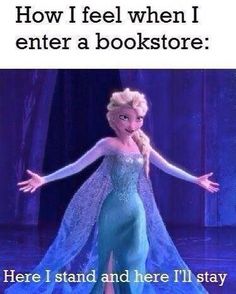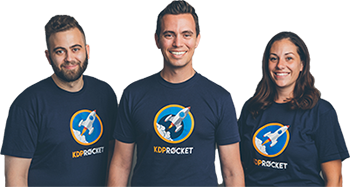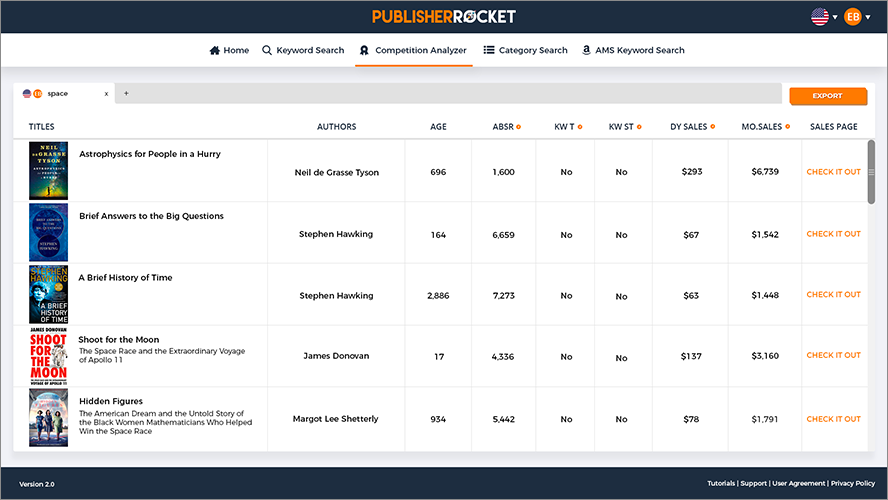Selling a lot of books online is great. But imagine what it would be like to sell lots of your books inside of real bookstores.
Imagine walking in and seeing your book on display. Think it's impossible?
Contrary to popular belief, it is not that hard if you are targeting the right bookstores. Unfortunately, many authors are targeting the wrong bookstores and constantly getting turned away.
I am Kallen Diggs, international bestselling author and host of Reaching the Finish Line. As being a bestseller in 6 countries, you would think that my book is sold in every Barnes & Noble bookstore. Well, that's not entirely true. People can special order my book, but you will not find it on their bookshelves.
Compared to Stephen King, J.K. Rowling, and Robert Kiyosaki, I am not a big name author.
I just use a great tactic to get my book in a select group of indie bookstores across the country.
The good news is that you can too! If you follow the steps below, in no time, you could be walking into a book store and seeing your work of art on display.
- Why you should avoid the big bookstores like Barnes & Noble.
- How indie bookstores can be more profitable to self-published authors
- How to get your book sold in indie bookstores (step-by-step)
- Advanced tips and tricks to bookstore sales and management
Table of contents
Avoid Barnes & Noble and the other BIG bookstores
Barnes & Noble is the last, major physical bookstore left. With Amazon physical bookstores, many people are wondering if Barnes & Noble will be able to stay afloat. I am not a fan of Barnes & Noble. For customers, it is great. Many of them use Barnes & Noble as a hangout place to read books with their latte.
For most indie authors, Barnes & Noble can be their worst enemy. Why? Well, there are not very friendly. I only got a book signing there because of my publisher (Morgan James Publishing). Although, it was not worth my time there at all. If I remember correctly, I sold almost 10 books during the book signing.

Furthermore, you will be competing with the big name authors like Robert Kiyosaki, Jack Canfield, Stephen King, and J.K. Rowling for shelf space and featured spots.
I personally do not like competition, especially when they favor the big names over the indie authors. Often, these big name authors are getting their own shelf, which usually sit at the end of the aisle. With such a great placement, their book significantly stands out from the rest of the books.
As a business, you cannot really blame them for doing such a thing. They are trying to make enough money to stay in business.
Become a Modern Author, Not Just an eBook Author
Fortunately, there is still hope for the indie author crowd. You can almost count on Barnes & Noble to not have your book stocked on their shelves. Although people can still buy it via special order if you publish through Ingram Spark or if your publisher has a distribution agreement with Ingram.
Either way is possible when you have a print version of your book.
PS: For those of you who aren't familiar with IngramSpark, it's a print on demand service like CreateSpace, but has different benefits and more customization. You can checkout the Kindlepreneur article that compares CreateSpace vs IngramSpark and learn when you should use either or.
Consider Working with Indie Bookstores
Contrary to popular belief, indie bookstores are thriving. According to the American Booksellers Association, the amount of independent bookstores has grown by 27%, despite being among The Great Recession.
Independent bookstores have grown by 27%, why not sell your book in this market as well?Click To TweetWell, you may say, “No one is buying print books anymore. That market is dying. eBooks are on the rise.”
Perception is not always reality. The Association of American Publishers has found that eBook sales declined last year. Adult books declined by 9%, while children and young adult books declined by 43%.
However, adult print books increased by 16%, while children and young adult paperback books increased by 9%. So, there is no need to worry. As stated before, indie bookstores will be your strongest allies!
Indie bookstores can do wonders for you. They will be more open to granting you more book signings than Barnes & Noble. They will give you better shelf placement than Barnes & Noble. Some of them will even buy your books on a non-returnable basis.
Types of Agreements: Speaking the Language

I sell 50 to 100 books to a select group of indie bookstores per quarter.
Every quarter, I request payment for my books and see if they are interested in buying more books at wholesale.
From my publisher, I can buy 250 books at $3.50 per book. I can get a cheaper discount with them if I bought 500 or 1,000 books. Although, for the new author, I would not suggest starting with 500 or 1,000 books. Do not overwhelm yourself. Start small and gradually work your way up.
Unlike mainstream bookstores, there are two business models that you can use for selling your books in indie bookstores. You can work with them via a traditional or consignment agreement.
Traditional Agreement
The traditional agreement would require you to sell your books at a 50% or 55% discount from the retail price. As an author, the best option would be to request that the books are non-returnable (or non-refundable). Some indie bookstores would not mind this particular arrangement if they have a large storage space for an extra 50 books.
Like the mainstream bookstores, some indie bookstores may only work with you if your books are returnable. With this arrangement, I would recommend selling them the minimum amount of books. This amount can be as small as a dozen of books.
I personally do not like buying back books because these books are often not “new” anymore. You can sell these “like new” or “used” copies on Amazon. After all, there will be other people selling your book there anyway. Why not make some money from those books?
So, with this agreement, you probably would not make more than $8 per book when you factor in returns.
For example, if the retail price of your book is $17.95, the bookstores would buy your book at a wholesale for about $9 apiece.
Although, if you had a publisher, you would not get that much. If your book publishing contract stated an 80/20 split on print copies, you would get about $1.80 royalty per book. Your publisher would get the other $7.20 ($1.80 + $7.20 = $9).
Remember the returns that I mentioned a few moments ago? Well, you will have to factor in the amount of returns as most book publishers offer this guarantee to bookstores.
Furthermore, if the bookstores are returning almost all of your books, then you will not be making as much as you expected from your books.
This is why you should be the publisher because you can often negotiate better terms with the bookstores. Why not earn up to $10 per book rather than being limited to a ceiling of about $1.80 per book?
You can only increase those odds when you sell your books on a non-returnable agreement. They can buy your books at about $8-$10 per book and pay you the upfront total amount.
Just imagine if you could sell 50-100 books to a few indie bookstores in your area. You could make $400-$1,000 from each bookstore per quarter.
Consignment Agreement
The other agreement is known as the consignment agreement. This agreement is a bit different than the traditional one. The bookstore will agree to a commission split rather than buying your books at wholesale.
For example, if the retail price of your book is $17.95, the indie bookstore will probably sell it for their retail price of $14.95. Believe it or not, some bookstores are happy to split the profits 60/40. That is 60% for you and 40% for them. Not all bookstores will agree to this commission split, but I like to start with that offer initially.
Drafting a Plan
So, how does one approach and secure the rights to sell in an indie bookstore? Follow these steps:
Step 1 – Use Google to search for indie bookstores within a 10 to 25-mile radius of your zip code. Then, create an Excel spreadsheet with a database of the bookstore name, business hours, phone number, and manager's name (if possible).
Step 2 – Call the bookstore and request to speak with the manager. Introduce yourself and tell the manager about your book. Keep it short, though.
Step 3 – Listen to determine if the manager has some interest in your book. Usually, if there is interest, he will get straight to the point by suggesting that you do a book signing and tell you his terms. If not, it does not mean that he is not interested. It simply means that he is not interested right now.
Always remember “NO” does not mean never. It just means not right now. For years, people have and will continue to change their mind. So, stay confident!
If a bookstore tells you not right now, return to step 2 with the next bookstore.
Step 4 – Once you both have agreed on an initial amount of books and a 60/40 or 50/50 agreement, then you will deliver the books to the bookstore. It is good to have a written agreement as a precautionary measure. Almost all bookstore managers will not scoff at signing your agreement. In fact, most of them will appreciate your professionalism.
Step 5 – Every quarter, call the bookstore to check the status of your book sales. If they are only a few of your books left, it will be easy to encourage them to order more from you. If you sold half of the books or even a few, you should suggest doing another event for the bookstore. Often, they will agree and help you promote the event.
Please remember that this is a numbers game. It is all about volume. You need to work with at least a half dozen bookstores if you want to net close to $10,000 a year in profits. What if you could double or triple your efforts? Then, that $10,000 becomes $20,000 or $30,000.

So, how many indie bookstores are in your area?
I would recommend focusing on your closest metropolitan areas that are without the big bookstores like Barnes & Noble and Books-A-Million. They are even some big independent bookstores that rival the local Barnes & Noble stores like BookPeople (Austin, TX) and Powell’s Books (Portland, OR). So, you need to exclude those stores too.
Just imagine if you could sell 50-100 books to a few indie bookstores in your areaClick To TweetSo, which indie bookstores should you target?
You want to target the small, indie bookstores. These bookstores sell about 200-500 different books. From this limited selection of books, it will be much easier to sell books in your particular category because your competition will be significantly less than it would be in the big bookstores. Additionally, people will be more likely to buy your book if there is not a big bookstore nearby.
The Final Word
Well, you may say, “They can just go home or on their phone to look for other books on Amazon.” You are right. They could, but it is not likely that they will do it.
Usually, you have two types of book customers: the customers who buy online and the customers who buy from the physical bookstores. As much as you may know online book marketing ideas, some customers will only ever shop offline. If the customer is already at the bookstore, it is very likely that they will buy a book there.
If you focus on working with at least a half dozen of indie bookstores located far away from the big bookstores, you will definitely sell more books! It is these bookstores that will be your strongest allies!
Do you have a favorite indie bookstore that you want to stock your book? Tell us in the comments!
Kallen Diggs is the international bestselling author of Reaching The Finish Line. He has been featured on Fox News and in The Huffington Post. He is also the creator of TIPTOP, a course that helps introverts and busy people get overwhelming publicity.








